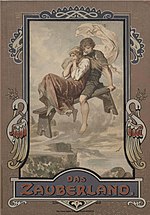Emil Engelmann (poet)
Emil Engelmann (born August 26, 1837 in Ötlingen , † March 10, 1900 in Stuttgart ) was a German sparkling wine manufacturer and writer in Stuttgart. He created popular adaptations of Germanic, Nordic, medieval and Greek sagas “for the German house”.
Life
Christian Emil Engelmann was born on August 26, 1837 in Ötlingen, today a district of Kirchheim unter Teck . Engelmann's parents were Luise Friederike Eckhardt (1809–1862) and the pharmacist Christian Gotthold Jakob Engelmann (1792–1871), a brother of the pharmacist and materialist Christian Gotthold Engelmann (1787–1847) . Emil Engelmann was the second of five children, the third child was his brother Albert Engelmann (1839–1885). The family moved from Ötlingen to Stuttgart in 1839, where the father founded a wine, liqueur and sparkling wine factory. Engelmann attended grammar school in Stuttgart and then joined his father's factory, where he later worked as an authorized signatory together with his brother Albert. After the death of their father in 1872, Emil and his brother Albert continued the company. After the death of his brother in 1885, Emil was the sole owner.
Emil Engelmann married Hildegard Elben (1849–1914), 12 years his junior in Stuttgart in 1868, the daughter of Otto Elben , publisher and chief editor of the Swabian Merkur , and of Sophia Kapff (1827–1900). The marriage produced three daughters and two sons between 1869 and 1882.
Emil Engelmann died on March 10, 1900 at the age of 62 in Stuttgart. His wife survived him by 14 years and died in Stuttgart in 1914 at the age of 65. Both are buried in a family grave in the Prague cemetery in Stuttgart in section 4.
plant
Engelmann's literary interest was primarily in the Germanic, Nordic, medieval and Greek legends. In his popular re-poetry, re-poetry and retelling, he mainly worked on heroic songs, fairy tales and legends for the German home, the world of women and the youth. His books owed their success to the easily understandable language and, not least, to the rich illustration.
Engelmann was also active as a poet, mainly as a party and occasional poet, whereby he “never tried to artificially increase his modest poetic talent”. At the annual Schiller Celebration of the Stuttgarter Liederkranz in May, "he contributed more than twenty times to the success of the festival with enthusiastic verses," which he spoke to the crowd from the base of the Schiller monument. The Liederkranz made him an honorary member.
As a songwriter, he published a selection of his dialect poems set to music by Ludwig Stark in 1881 under the title “From the Swabian Land”. In 1886 he also published 50 old folk songs under the title “The Minnesinger. 50 old songs in new ways ”.
Catalog raisonné
- Folk tales and legends of the gods from Germanic prehistory. Epic seals. Stuttgart: Bonz, 1880, pdf 1882 .
- The most beautiful tales and legends of the past. According to the sources. With 12 illustrations. Stuttgart: Neff, 1884.
- The Nibelungenlied. Edited for the German house from the best sources. Stuttgart: Neff, 1885.
- The Gudrun song for the German house. In free repositioning. With a facsimile of the Ambras manuscript, 6 photographic images and many illustrations in the text. Stuttgart: Neff, 1886, pdf 1892 .
- The Frithiof legend. The song by Frithiof the Bold for the German House based on the sources of the old Icelandic and Tegner's Frithiofs saga. Stuttgart: Neff, 1887.
- A few things about Parzival and Nibelungenlied manuscripts from the St. Gallen Abbey Library. In: Writings of the Association for the History of Lake Constance and its Surroundings, Volume 16, 1887, Pages 85–88, pdf .
- Parzival. The song of the Parzival and the Grail. After the songs of Wolfram v. Eschenbach and Christian v. Troies edited for the German house. With 3 facsimiles of the St. Gallen manuscript, 6 collotype images and 67 illustrations. Stuttgart: Neff, [1888], pdf 1894 . - Afterword of August 26, 1887.
- Germania's Sagenborn. Tales and legends edited for the German house.
- Homer's Odyssey. In free repackaging for the German house. Stuttgart: Neff, 1891.
- The Pentecost trip. A funny song from the Black Forest in 6 adventures. Stuttgart: Neff, 1893.
- Nordland sagas. Edited Nordic-Germanic songs and tales for the German home. Stuttgart: Neff, 1895, pdf .
- The fairytale forest for the German house. With six full pictures by RE Kepler and E. Weißer. Stuttgart: Neff, 1895.
- Sagas of classical antiquity. Published by Gustav Schwab. Edited freely for the youth. With six color prints by A. Zick. Stuttgart: Loewe, [1897], pdf . - Dedication poem "im Lenz 1897".
- The magic land. New fairy tales for the youth. Collected by Emil Engelmann. With 5 color prints by A. Zick. Stuttgart: Effenberger, [1898], pdf .
- Fairy tale pictures from Germanic prehistory. Seals. Pictures by E. Weisser. Stuttgart, [no year].
literature
- Rudolf Krauss: Engelmann, Emil. In: Biographisches Jahrbuch und deutscher Nekrolog, Volume 5, 1900, pages 160–161.
Web links
Footnotes
- ^ Family register 10.237, Stuttgart City Archives. - The grave of Luise Friederike Engelmann geb. Eckhardt is on the Hoppenlaufriedhof in Stuttgart in department 5b, → photo . Immediately next to it was her husband's grave, which has not been preserved.
- ↑ # Krauss 1900 .
- ↑ family register 22723, city archives Stuttgart.
- ↑ # Krauss 1900 .
| personal data | |
|---|---|
| SURNAME | Engelmann, Emil |
| BRIEF DESCRIPTION | German writer |
| DATE OF BIRTH | August 26, 1837 |
| PLACE OF BIRTH | Ötlingen , Germany |
| DATE OF DEATH | March 10, 1900 |
| Place of death | Stuttgart , Germany |





